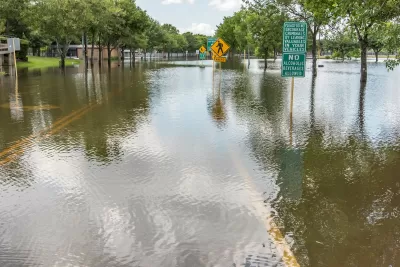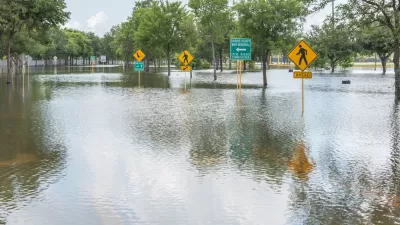Most of the census tracts designated at high risk of flooding are in less affluent neighborhoods.

A report from First Street Foundation highlights the parts of Houston designated as “climate abandonment areas,” census tracts that households are leaving in part due to climate change-related flood risk. These households are not being replaced by new incoming residents. Roy Kent describes the report in the Kinder Institute for Urban Research’s Urban Edge, which notes that 9 percent of Harris County census tracts are abandonment areas.
Climate abandonment areas include the cost of a home based on its location along with the added costs associated with higher rates for homeowners and flood insurance policies. Higher costs often drive some homeowners out of the neighborhood to nearby areas with lower insurance rates due to a lower flood chance.
According to the report, “climate abandonment areas of Houston are predominately in less affluent neighborhoods with older infrastructure spread across the city but generally located inside the 610 Loop.”
Jeremy Porter, head of climate implications research at First Street, says “The downstream implications of this are massive and impact property values, neighborhood composition and commercial viability both positively and negatively.”
The report notes that Texas has faced the highest disaster recovery costs of all states, with over $300 billion in damage from tropical storms and hurricanes, droughts, and winter storms since 1980.
FULL STORY: Residents leave Houston neighborhoods thanks in part to climate change

Trump Administration Could Effectively End Housing Voucher Program
Federal officials are eyeing major cuts to the Section 8 program that helps millions of low-income households pay rent.

Planetizen Federal Action Tracker
A weekly monitor of how Trump’s orders and actions are impacting planners and planning in America.

Ken Jennings Launches Transit Web Series
The Jeopardy champ wants you to ride public transit.

Rebuilding Smarter: How LA County Is Guiding Fire-Ravaged Communities Toward Resilience
Los Angeles County is leading a coordinated effort to help fire-impacted communities rebuild with resilience by providing recovery resources, promoting fire-wise design, and aligning reconstruction with broader sustainability and climate goals.

When Borders Blur: Regional Collaboration in Action
As regional challenges outgrow city boundaries, “When Borders Blur” explores how cross-jurisdictional collaboration can drive smarter, more resilient urban planning, sharing real-world lessons from thriving partnerships across North America.

Philadelphia Is Expanding its Network of Roundabouts
Roundabouts are widely shown to decrease traffic speed, reduce congestion, and improve efficiency.
Urban Design for Planners 1: Software Tools
This six-course series explores essential urban design concepts using open source software and equips planners with the tools they need to participate fully in the urban design process.
Planning for Universal Design
Learn the tools for implementing Universal Design in planning regulations.
Ada County Highway District
Clanton & Associates, Inc.
Jessamine County Fiscal Court
Institute for Housing and Urban Development Studies (IHS)
City of Grandview
Harvard GSD Executive Education
Toledo-Lucas County Plan Commissions
Salt Lake City
NYU Wagner Graduate School of Public Service





























